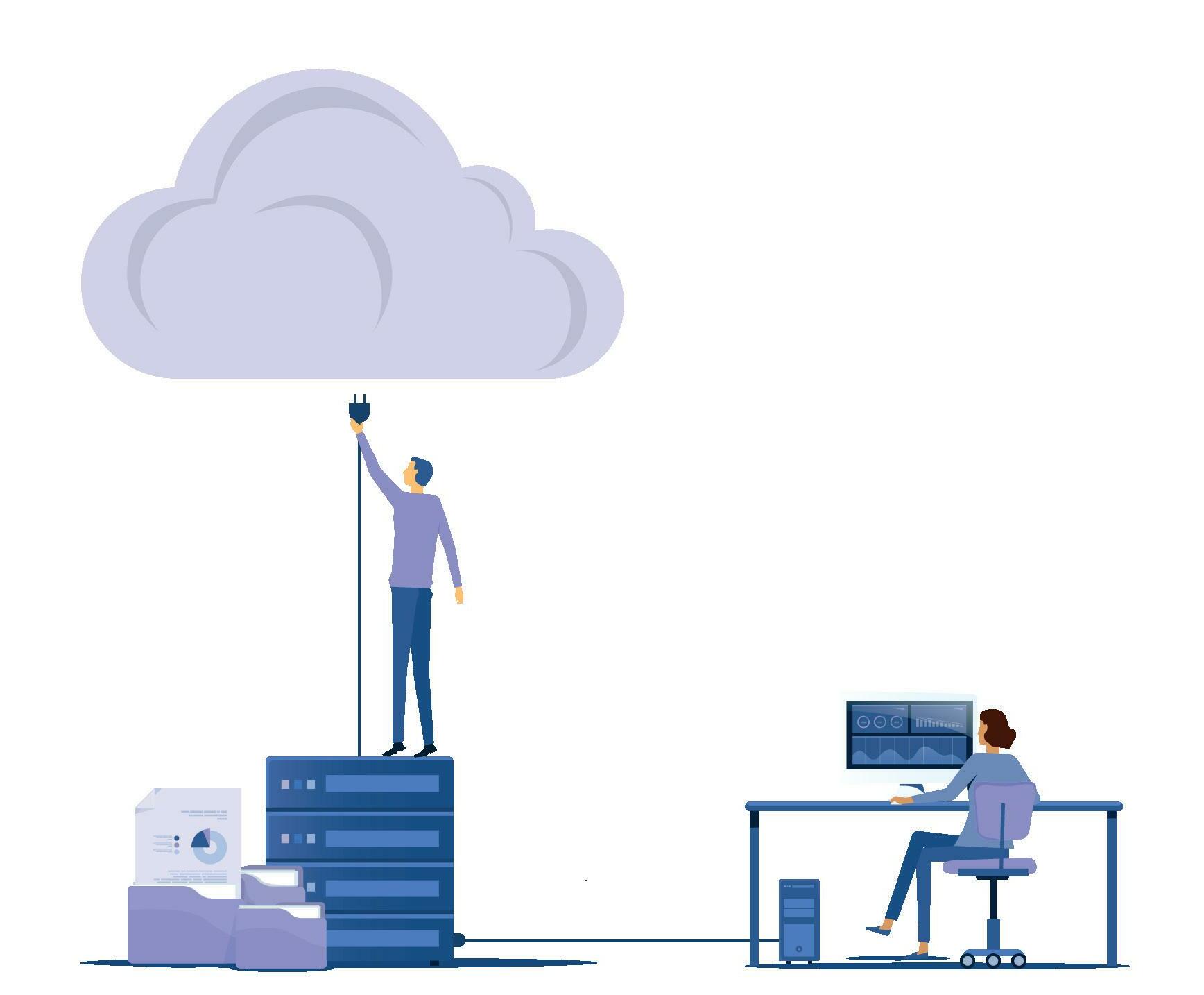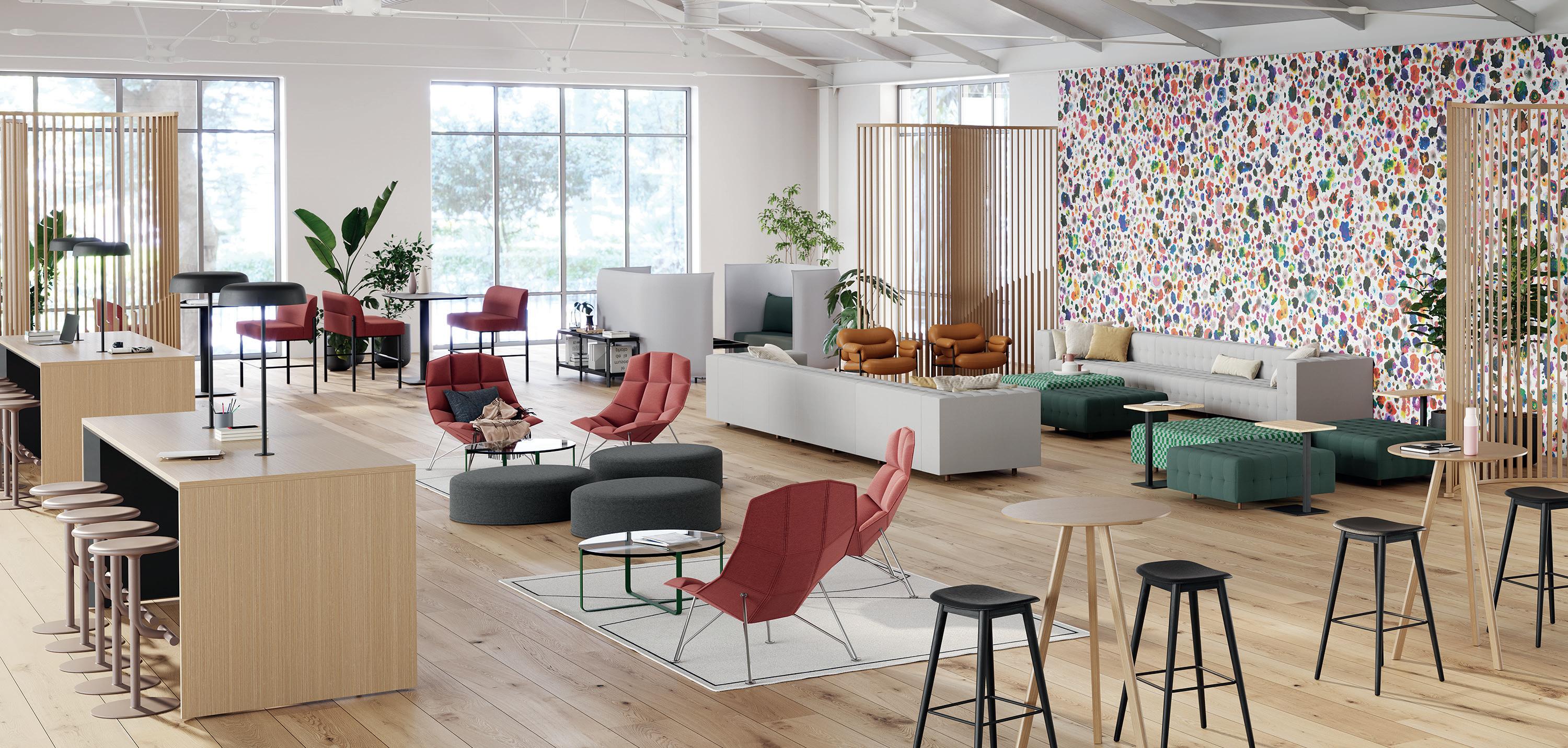Future of Work
www.businessandindustry.co.uk


“Employers may question the value of changing their recruitment practices.”
“Employers should create, update and appropriately resource their financial wellbeing policies.”

www.businessandindustry.co.uk


“Employers may question the value of changing their recruitment practices.”
“Employers should create, update and appropriately resource their financial wellbeing policies.”
Employers are failing their staff with poor technology and little trust — but a better way of working is emerging.
Long days, no breaks and poor productivity have become the reality since the Covid-19 pandemic, as hybrid working and the pressure to be present at all hours have become commonplace. This ‘green tick’ culture has made hybrid working a double-edged sword. However, a better way is emerging: asynchronous work.
Asynchronous working is the future Instead of working a nine-to-five, asynchronous work allows team members to be online at different times, working around their personal commitments. However, good technology and cooperation from employers are essential for asynchronous work — something many don’t have.
According to a survey of 3,000 white-collar office workers from Sony Professional Displays and Solutions, 58% of office workers don’t believe their company has the technology needed to facilitate asynchronous work, yet only 31% go into their office to access better technology.

This leaves a large chunk of people working from home without the resources they need to achieve their full potential, leaving employees demotivated and employers losing out. You wouldn’t expect a sprinter to win gold in wellies, so why should an employee be expected to perform with poor tech?
Not only will embracing asynchronous work make current employees happier and increase efficiency, but it will help companies attract future talent in an increasingly competitive environment. Demonstrating that you trust your employees to work when they choose sends a strong signal that you value them.
Ensuring workspaces are equipped with the right technologies is equally as critical. Yet, Sony’s survey suggests employers are failing at this, as 55% of workers believe their employers don’t trust staff to work asynchronously. Another 39% of office workers believe a ‘people first’ approach is the most important aspect of the future of work and that access to up-to-date technology for flexible working is of ‘great importance.’
Employees are making it clear: the future of work relies on putting people first — from trusting employees to manage their own time to giving them the tools they need.
If you want to make sure your business and workforce know how to be cloud-capable, join us at techUK to hear from leading cloud adopters.
Find out more at techuk.org


Moving the workforce to the cloud makes businesses more agile
Cloud is making it easier for organisations to empower their workforce with new digital tools, agile working practices and the latest emerging technologies like artificial intelligence. This could lead to a new generation of data-driven businesses across the economy.

Adapt to the needs of a cloud-enabled business
Cloud is part of a broader shift from capital investment to operational expenditure across the IT industry. While this can enable greater automation and flexibility — such as freeing workers to focus on tasks that add more value — it also creates new job roles in actively managing cloud use to make it as cost-efficient and sustainable as possible.
For example, using cloud-based technologies, Costain has managed and maintained data in a responsible way while following best practices around data storage and archiving to support their net zero goals. At the same time, flexible cloud-based digital platforms help them integrate applications, systems and data.
Investment in supporting employees to use such tools is crucial. The findings of techUK’s recent Digital Economy Monitor survey show that 30% of techUK members need better training and skills support in order
Employees should be given back some of the extra time created by automation and more flexible cloud tools to focus on development and learning skills in new areas.
to grow and prosper. Employees should be given back some of the extra time created by automation and more flexible cloud tools to focus on development and learning skills in new areas. Upskilling and re-training are needed to make full use of digital capabilities.
Wellbeing-focused and human-centred design
The increased productivity potential of a cloud-enabled workforce — with greater flexibility and collaboration tools bringing people together — is a key driver of the workforce of the future. This needs to be led with people-first thinking so that the digital transformation is sustainable. Companies should look to fostering digital confidence in the tools they provide. Gartner predicts as many as 85% of organisations will embrace a cloud-first principle by 2025. Let’s get future-ready.
642 0737
HR leaders warn that they are increasingly burnt out and considering leaving the profession amid rapid change within the industry, according to a no-holds-barred report into the sector.
More than half of senior HR and People practitioners say they still ‘love their job’ — but more are burnt out, findings of a new report show. Other concerns centre around the dramatic pace of change in the last years; the continued frustrations at the focus on paperwork and process rather than people; and the need to embrace technology to support workload and efficiency.
The report on the HR sector has been produced by UK tech company Sage and highlights the current position and mood within the industry. It also identifies steps to prepare it for the future. Report author Jess Fuhl, who is Head of HR Research and Thought Leadership at Sage, says: “Like many business leaders over the last few years, HR leaders have been through and had to respond quickly to a lot: a shift to remote working, the Covid-19 pandemic and managing furlough — and legislation changes in the UK. They’re now facing how to manage workforces through economic uncertainty and provide support for employees at a time of managing fixed costs tightly. The challenges and changes continue within HR.”
“We wanted to understand how HR is responding to those challenges, what support HR leaders are getting and need, as well as the role technology could play.”
Another discussion was about moving away from the outdated term ‘human resources’ — which continues to suggest ‘admin function’ — to being known as ‘People Function’ or ‘People and Culture.’ While 91% of HR leaders and 95% of C-suite are excited about the future of HR, 66% retain worries. “There are some positives,” continues Fuhl, “But it is an unprecedented time in HR. The extent of how stressed and burnt out HR leaders are, was a worrying finding.”
Increased automation
Technology can improve HR efficiency, but it has not gone unnoticed that the marketing and finance sectors are ahead in transitioning to digital and analytical-focused approaches.
Fuhl says: “HR teams are using automation, but not to the extent they need to. Automating processes — whether in recruitment or analytics — frees up time to concentrate on more strategic matters.” Currently, only 54% of departments use automation, and many HR leaders believe they don’t have the right technology or skills in their teams.

From the poll of more than 1,000 HR leaders and C-suite executives, ‘The Changing Face of HR’ report found that 57% of HR leaders love their job, 62% are considering leaving, 81% feel burnt out and 73% remain worried that the focus is still more on processes than people.
Many want to find ways of spending less time on admin and paperwork by implementing more automation — freeing up time to concentrate on people, strategy and productivity. In terms of career advancement and stepping up from a CPO (chief people officer) to CEO, 91% believe they have the skills to move into the senior role, but only 13% identified financial performance as a priority, says Fuhl.
The shift to automation is paramount for HR teams wanting to spend less time on processes and paperwork — and more on meaningful people strategies. Meanwhile, actionable analytics can deliver insights to allow HR leaders immediate access to data such as headcount, activity levels, recruitment and turnover rates.
The report from Sage — which provides finance, accounting, HR, payroll services and advice to UK businesses — identifies key needs to help HR better prepare for the future. This includes increased upskilling; more technological know-how; more investment in HR specialisms such as Diversity, Equity and Inclusion (DEI); increased wellbeing initiatives to prevent burnout; and better peer-to-peer networks. The top priorities for HR in the future are talent management, DEI and employee health and wellbeing.

Currently, only 54% of departments use automation, and many HR leaders believe they don’t have the right technology or skills in their teams.
Organisations building a culture of care around their people to help them through the cost of living crisis are embedding support services that will, in the future, be beneficial for everyone.
As inflation soars, interest rates rise and energy prices spiral, more of us are either struggling — or going to struggle — with the cost of living.
“Organisations learned an important lesson during the Covid-19 pandemic,” says Kate Field, Global Head of Health, Safety and Wellbeing at business improvement and standards organisation, BSI. “Those that built a culture of care around their people came out of the crisis stronger and with a more loyal workforce. It’s one reason why many organisations are proactively looking at ways to support their staff during this difficult time.”
Signs that people are struggling
Of course, it may not be easy to recognise those who are struggling financially. “Some staff might simply ask for more money or overtime, or they’ll leave for a better-paid job,” says Field. “But it won’t always be that obvious, so organisations need to be aware of the less overt signs among their workforces.”

“For instance, someone might be increasingly tired because they’re having to take on extra work outside of their normal job. Or, because people are concerned about job security, they won’t take time off even when they are unwell; so presenteeism — ie. being at work physically but unproductive — could become an issue. Also, work-related stress and anxiety could increase, so you might see a drop-off in morale.”
The fact is that the more secure employees feel, the more loyal and productive they will be.
Have effective support systems in place
Field also notes that some larger organisations have been able to make a one-off extra payment to help with the cost of living crisis. But that may not always be a realistic option for most employers.
“However, there are things they can do such as adopting hybrid working, so that staff can save money on their commute,” she says. “Some organisations — shops, leisure facilities, restaurants, etc. — can’t do that, obviously; but the ones who can, may wish to consider it. I’m also aware of organisations with a canteen serving breakfasts and lunches and parcelling up leftovers at the end of the day for people to take home. So, we are seeing a different level of care and thought, and that’s partly down to what organisations have already been through during Covid-19.”
The next challenge for employers is delivering support that actually works. What form should it take? Some organisations will operate an Employee Assistance Programme (EAP) — a free and confidential benefit that is designed to help staff deal with any personal or work issues that may be affecting their health or wellbeing.
“This might give employees access to financial advice, either online or through a financial advice service, which could be really useful,” says Field. “Unfortunately, EAPs are often an underused resource (their average take-up is around 5% to 7%), so it’s vital to signpost them clearly to make employees aware that they are available and, crucially, confidential.”
How caring builds strength
Field’s main piece of advice to any organisation is: Be honest with your people and talk to them openly and regularly. “Transparent communication is key,” she insists.
“Often, the temptation is for organisations to keep financial concerns hidden. But the more you can engage with your staff and talk to them about this issue, the better. They might even come up with ideas you hadn’t considered or be more flexible about their working week in a way that you hadn’t imagined. The fact is that the more secure employees feel, the more loyal and productive they will be. And, as we come out of this challenging period, organisations that care about their people will be in a stronger place to attract and retain the best talent going forward.”
Those that built a culture of care around their people came out of the crisis stronger and with a more loyal workforce.SPREAD INTERVIEW WITH Kate Field Global Head, Health, Safety and Well-being, BSI SPREAD WRITTEN BY Tony Greenway
With digital tech going through a huge growth stage, organisations are assessing how they best approach their digital futures, and it’s taking them to some exciting places.
Ditching analogue and embracing digitisation is not a new phenomenon in business, admits Kate Field, Global Head of Health, Safety and Wellbeing at BSI. “In the automotive sector, robotics have been used on production lines for decades,” she says. “In engineering, manual tools have been replaced by CNC (computer numerical control) machines.”
What digital technology will look like Field says, “None of this is new. It’s just that digital technology is going through a huge growth stage at the moment.” There are several reasons for this. Firstly, digital tools are more affordable and accessible than ever. Secondly, the IT behind digital has improved so much that it can now be used in ways that weren’t previously possible.
What’s interesting is where digitisation is heading because it’s yet to reach its full potential. If they haven’t adopted them already, organisations are investigating how they can include big data, artificial intelligence (AI), wearable tech and augmented reality (AR) in their growth plans.
information from large volumes of data. This frees up humans to concentrate on the things they are good at — which can’t be replicated by technology — such as critical thinking, conflict resolution and empathy.
Being responsible with your tech Naturally, cybersecurity remains a central concern. Staff need to understand how they can be manipulated by phishing scams or that logging into work via an external network — such as the internet at their favourite coffee shop — will not be as secure as their organisation’s own system. “It’s vital that employees know the risks, especially with bad actors becoming more sophisticated,” says Field.
There are data protection issues to consider. “A lot of tech gathers data,” says Field, “Think of hi-vis jackets worn by security staff which can be fitted with smart sensors that monitor the wearer’s heart rate. That’s a great way to look after your people, but it’s technology that generates personal medical data, so data governance must be managed robustly.”
Failure to embrace and deploy digitisation may result in challenges hiring diverse talent
It might even mean their employees entering the metaverse (think of it as the internet in 3D), an immersive experience which allows them — or their avatars, at least — to attend meetings or training sessions while they are sitting elsewhere wearing a virtual reality (VR) headset or AR glasses. All of which are going to have a massive impact on the future of work and organisational culture.
Employers may have to deal with the concerns of employees, who might worry about being replaced by increasingly smarter tech. “Yet, robotics on car production lines didn’t reduce jobs,” argues Field.
“And CNC machines still need operators and engineers. Digital improves the quality of jobs so that people don’t have to do things that are dangerous or might impact their physical or mental health.” Plus, computers can now perform menial tasks at speed, such as extracting
Making the design of digital tools inclusive Future-looking organisations are focusing on how they can upskill staff properly to better prepare them for the unfamiliar digital tech they know is coming. On the other hand, Gen Z candidates may have higher expectations for employers to offer more digitally enabled modes of working.
Digital tools must be designed in an inclusive way so that everyone can use them. “Think about your workforce’s digital wellbeing,” says Field. “What are their needs, expectations and concerns regarding this technology? If you talk to them early to find out, they are more likely to go on the digital journey with you.”
Field concludes: “Failure to embrace and deploy digitisation may result in challenges hiring diverse talent. Therefore, organisations who fail to live in this new, digitally transformed environment are likely to fall behind in the war for talent and in delivering products and services to today’s competitive markets.”

Many established recruitment practices may be preventing jobseekers from entering employment, causing businesses to miss out on untapped talent.
WRITTEN BY Charlotte Gibb Employment and Skills Campaign Manager, Business in the CommunityBusinesses in the UK are facing a talent crisis. Reports of the Office for National Statistics show that the UK has reached a challenging ratio of less than one jobseeker for every vacancy, making it difficult for employers to recruit. Many of the factors driving this labour market are beyond the control of employers, such as Brexit and the impact of the Covid-19 pandemic. However, the struggle to recruit offers an opportunity for employers to examine their recruitment practices, which are within their power to change.
Traditional recruitment practices can prevent some jobseekers — older workers, school leavers, refugees,
people with disabilities and those with former criminal convictions, etc. — from entering employment. For too long, the impact of these practices has gone unnoticed, because vacancies have been easy to fill. However, unless changes are made to their recruitment practices, employers will find that certain jobseekers will remain overlooked, and they will miss out on an incredible range of talent.
In addition to filling vacancies, Business in the Community’s opening doors campaign encourages inclusive recruitment practices to hire untapped talent that will help employers create a more diverse workforce. This benefits the bottom line, with more diverse companies
outperforming the competition. In a study by McKinsey & Company encompassing over 1,000 companies across 15 countries, researchers found that companies with the highest gender diversity at the executive level were 25% more likely to have higher profitability than less diverse businesses.
It’s also useful for talent attraction. British Psychological Society found that 69% of millennial and Gen Z employees shared that they would be more likely to work for an employer for more than five years if the business had a diverse workforce.
By focusing on essential skills and capabilities rather than education, experience or qualifications, businesses can fill skills shortages.
By reviewing where jobs are posted or working with partners like Bridge of Hope, Renaisi or Movement to Work, businesses could unlock new pathways for jobseekers.
Employers may question the value of changing their recruitment practices, but if they don’t adopt inclusive recruitment practices now, disadvantaged applicants will find it even harder to compete for jobs should the UK enter a recession.
By making changes now, UK businesses can ensure inclusivity in the future world of work — with no one left behind in recruitment.
The cost of living crisis is taking a heavy toll not just on our wallets but also our mental health. All UK employees are likely to have noticed an unwelcome increase in essential expenditure, but people on low incomes and those who receive benefits because their mental health prevents them from earning enough are among those worst affected.
The relationship between money and mental health can be a vicious circle. People with mental health problems are more likely to experience financial problems and typically earn less, while financial issues can worsen our mental health.
Mind’s Infoline has seen a 40% rise, compared to last year, in calls from people experiencing difficulties related to finances such as welfare, unemployment and personal debt.
Despite the prevalence of financial and mental health concerns across the nation, according to the Chartered Institute of Personnel Development (CIPD), only 18% of organisations have a financial wellbeing policy — either as part of a wider employee health and wellbeing policy (14%) or as a standalone financial wellbeing policy (4%).


Employers should create, update and appropriately resource their financial wellbeing policies, covering things like how the organisation supports employee financial wellbeing; how they intend to create a supportive and
inclusive culture; how support and communications will be tailored to different employee groups at various stages of their employee life cycle; and sources of free and impartial external support.
Having a sense of control of your personal finances is key to addressing financial anxiety. Educational programmes delivered in-house around budgeting, pensions and planning for retirement can help. However, bear in mind that for many people — especially those on lower incomes — no amount of careful budgeting can help them make impossible spending decisions such as paying bills or putting food on the table. Existing benefits offered to staff — including hardship loans, pay advances, advice services, or financial support such as travel loans — should be well promoted and easy to access.
Employees should be given as much flexibility as possible in terms of hours and location so they can find a working pattern that least impacts their expenses and best supports their wellbeing. Such decisions may factor in the need to spend time with colleagues face-to-face, the costs of travelling to the workplace and the costs of energy consumed while working from home.
Examining the role that the office plays in our built environment has never been more important.
The next BCO conference in Dublin will explore the evolving role of the office as a vital part of an ecosystem, blending work, life, technology and data to ensure the social, economic and environmental sustainability of cities.


Social impact is high on the agenda for all organisations as they face the challenge of navigating a volatile economy and attracting and retaining talent while delivering ESG targets. The best offices will not only support a sustainable and productive work culture and employee wellbeing but also engage with their surrounding communities in impactful ways.
Our recent research reports have investigated many mission-critical themes.
The broader futureproofing of our office buildings is just as important. In our most recent investigation, we provide circular economy guidance to the office sector in relation to new-build, refurbishment and fit- out. ‘Circular Economy in Offices’ sets out how offices can be designed and constructed to eliminate waste and pollution, circulate products and materials as well as regenerate nature.
Offices account for 15% of the total commercial property sector’s waste and 44% of the construction sector’s waste.
In our ‘Future of UK Office Densities’ paper, we recommend a new method for calculating the amount of space needed per person in the post-Covid-19 world of work. It suggests that, before the Covid-19 pandemic, densities were being pushed too far, and employees should reasonably expect more space when they are in the office. A new ‘sweet spot’ of 10–12m2 per person reflects the significant increase in people working from home and hotdesking when in the office, while simultaneously ensuring that office workspaces meet employees’ requirements, promote productivity and reduce carbon emissions.
The landscape of workspace design has rarely undergone such a seismic shift as in recent years.
No longer simply a place to work, the workplace is now an infrastructure for building social capital and fostering a sense of purpose and belonging.

Workplace shift, culture lift According to the Oxford Dictionary, an office is ‘a room, set of rooms or building where people work, usually sitting at desks.’ But this definition should be redefined to something that is much more in keeping with today’s requirements. The working environment must now be an engaging, purposeful space that encourages collaborative working, vibrant company culture, enhanced
The research focuses on three circularity principles: retain what is already there, extend the life of materials and reduce the impact of anything introduced. The construction sector is one of the largest consumers of materials and produces more waste than any other sector in the UK. Offices account for 15% of the total commercial property sector’s waste and 44% of the construction sector’s waste.
Fit-out is the most significant opportunity to embed circular principles within the office sector and can help to meet urgent goals around climate change, waste generation, material extraction, pollution and species decline.
The vibrant city of Dublin will provide the perfect setting for the BCO’s membership to debate all of this and much more.
To learn more, visit bco.org.uk
the term “Redefining the O Word” – campaigning for the Oxford and Cambridge Dictionary to change their definition of the word to reflect the industry’s current ambitions for the workplace.
Crisis accelerates change Hybrid working is here to stay, yet its shape is shifting, as soaring energy prices and a desire to socialise add to the appeal of the workplace. But to meet modern expectations, the workplace needs to prove its worth when compared to working from home, with better amenity provision playing a key role.
productivity and overall happier people who produce a better standard of work than ever before.
How to redefine the ‘of**ce’ We believe the definition should be ‘A designed space where an organisation’s engagement, collaboration, culture and productivity are enhanced via its people, to achieve stated objectives and goals.’ It’s a definition that does not restrict or limit the way we work but instead empowers a workforce to be the best that they can be.
We are committed to creating the future of the working environment. Our belief in this mission is resolute, and as such we have trademarked
Living and working more sustainably is also a driver. Natural materials and local manufacturers are very much ‘in,’ with many firms pushing for stylish refurbished and reclaimed items, from statement furniture pieces to artworks. At a macro level, there is an emphasis on updating and adapting commercial premises, rather than knocking buildings down and starting afresh. When implemented well, intelligent design reinforces and supports new working practices, enhancing creativity, and in turn, making people happier and more productive. Savvy businesses will recognise the workspace as an essential tool for businesses to attract and retain high-calibre employees in this shifting marketplace.
We just need to redefine it.
With work and life entering a new era, organisations have an opportunity to reimagine the role of the modern workplace.
WRITTEN BY Ryan Anderson Vice President, Global Research and Insights, MillerKnoll
Since the pandemic, the world’s understanding of the very notion of ‘work’ had to expand beyond the range of activities that takes place in an office.
More people are resigning
Organisations across industries began testing out distributed work strategies, but a lack of serendipitous interactions and impromptu face-to-face conversations have led to an erosion of both the ‘weak ties’ and the stronger workplace connections that are vital to long-term morale and wellbeing.
Those companies that tried to hit the snooze button on this acknowledgement are already feeling the consequences. Many (71%) workers who are dissatisfied with the flexibility their employers offer are open to looking for a new job in the next year (Future Forum, 2022). Data suggests this so-called ‘Great Resignation’ may not be a blip, but rather a trend with potential to expand beyond 2022.
The pandemic fuelled a widespread embrace of flexible work practices. But changes that started as triage have shown incredible resilience, quickly becoming ingrained and deeply valued among workers across industries and geographies. Flexibility and choice have become expectations — and these expectations are not budging.
In response, many organisations have turned to hybrid workplace strategies to help reverse these trends. They recognise hybrid’s potential to foster trust and deliver more equitable experiences for employees.
However, it’s not enough for organisations to provide their people with a choice of where to work on a given day. Organisations must also ensure the quality of those choices — at home, in a co-located office or elsewhere — with resources and support.
Collaborative work is an ebb and flow of coming together and working independently. By following more of a neighbourhood model — in which team space is owned and individual spaces are shared within it — the modern workplace can provide a more immersive team experience that better supports the full range of collaborative work.
Individual focus and reflection
The past two years have stressed our homes in many ways. If you had a room to spare, it became a home office, classroom or gym. If you didn’t, finding focus has been a challenge.
Team members who need time alone to form well-rounded thoughts, ideas and creations require spaces within the modern workplace where they can achieve deep, productive focus while still staying connected to their organisation.

Strengthen your community through belonging
When workplace strategy gives everyone equal footing to be productive and successful and spaces designed to address the needs of the broadest array of people, something greater is achieved.
Consider the problems facing your organisation today. To solve them, you need more voices at the table, all of whom feel comfortable contributing their perspectives.
At MillerKnoll, we see the power of design as an instrument for positive change.
We’re ready to use that power to help you and your organisation provide more equitable experiences through inclusive design, fostering a greater sense of belonging among your people.
Find out more at millerknoll.com
Hybrid working gives people the flexibility to choose to work outside of the office when that’s the best choice for them and their work. But the office itself can be reimagined to better support the full range of work experiences that hybrid workers want to have when they do come into the office.

Community restoration
Humans are social beings longing for connection. By providing areas that encourage people to interact with their extended networks, the modern workplace can help restore a sense of community.